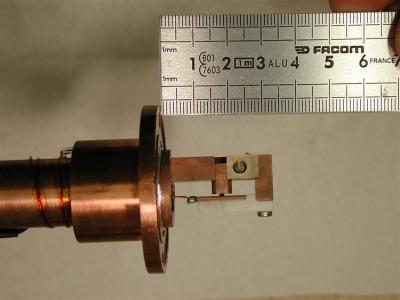Smallest atomic displacements ever may lead to new new classes of electronic devices
September 6, 2011

Sample holder used in the experiment. The small gray crystal of TbMnO3 that was studied, is in the center, between two electrodes used to apply an electric field. (Credit: Luigi Paolasini)
An international team of scientists has developed a novel X-ray technique for imaging atomic displacements in materials with unprecedented accuracy, using a recently discovered class of exotic materials — multiferroics — that can be simultaneously magnetically and electrically ordered.
Multiferroics are also candidate materials for new classes of electronic devices.
The researchers are from the European Synchrotron Radiation Facility (ESRF) in Grenoble (France), the University of Oxford, and the University College London.
Ferroelectrics exhibit electrical polarization. The new exotic “multiferroic” materials combine both magnetic and ferroelectric polarizations, and can exhibit a strong coupling between the two phenomena.
This leads to the strange effect that a magnetic field can electrically polarize the material, and an electric field can magnetize it, which can be used in new electronic devices. One example is a new type of electronic memory, in which an electric field writes data into the memory and a magnetic detector is used to read it. This process is faster and uses less energy than today’s hard disk drives.
However, the origin of the electric polarization in multiferroics remained mostly elusive to date. The team’s work unambiguously shows that the polarization in the multiferroic studied proceeds from the relative displacement of charges of different signs, rather than the transfer of charge from one atom to another.
As the displacement involves a high number of electrons, even small distances can lead to significant polarization. The actual distance of the displacement still came as a surprise: about 20 femtometers, or about 1/100,000th of the distance between the atoms in the material. Measuring such small displacements was actually believed to be impossible.
The researchers developed a new experimental technique exploiting the interference between two competing processes: charge and magnetic scattering of a powerful, polarized X-ray beam. They studied a single crystal of TbMnO3, which shows a strong multiferroic coupling at temperatures below 30K, and were able to measure the displacements of specific atoms within it with an accuracy approaching one femtometer (10-15 meter). The atoms themselves are spaced apart 100,000 times this distance.
The new interference scattering technique has set a world record for accuracy in absolute measurements of atomic displacements. (It is also the first measurement of magnetostriction in antiferromagnets.) Most significantly, the identification of the origin of ferroelectricty in a multiferroic material is a major step forward in the design of multiferroics for practical applications.
Ref.: H.C. Walker, et al., Femtoscale Magnetically Induced Lattice Distortions in Multiferroic TbMnO3, Science, 2011; [DOI: 10.1126/science.1208085]